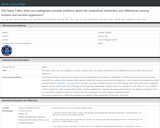
This video illustrates the evolutionary process of speciation.
- Subject:
- Science
- Material Type:
- Demonstration
- Provider:
- The Cornell Lab of Ornithology
- Date Added:
- 08/21/2018

This video illustrates the evolutionary process of speciation.

This virtual lab teaches skills of data colleciton and analysis to study evolutionary processes using stickleback fish and fossil specimens.

An introductino to evolutionary theroy. Giving us credit when you use our content and technology is not just important for legal reasons. When you provide attribution to CK-12 Foundation, you support the ability of our non-profit organization to make great educational experiences available to students around the world.Our Creative Commons License welcomes you to use our content and technology when you give us attribution. If you have any questions about our policies, contact us at support@ck12.org

Students access their prior knowledge of the anatomical similarities and differences among modern and fossil organisms by creating a Venn diagram with a partner, which will compare and contrast two organisms. Next, students will complete the online modules found at "What did T. rex Taste Like?" from the University of California Museum of Paleontology, which will explain how a cladogram diagram can be used to show lines of lineage and evolutionary relationships. Students will use a cladogram to infer how a T. rex is related to modern organisms. Lastly, students will construct a written explanation to describe the anatomical similarities and differences between the T. rex and modern organisms based on evidence from the cladograms in a claim-evidence-reasoning format.

Review all diagrams and charts for Investigations 1 through 4 for junco populations DNA.

Students sort lizards by appearances, then generate a phylogenetic tree using the lizards' DNA sequences to evaluate whether species that appear similar are closely related to each other.

This interactive resource presents how paleoanthropology provides an excellent example of the scientific process at work.

Students compare and contrast the anatomy of the heart and the circulatory systems of major vertebrate groups and gain insights into their evolution.

With this interactive, based on the Wall of Birds mural, students explore species from all surviving bird families alongside a select group of extinct ancestors. Students can make comparisons of anatomy, native ranges, and distinctive voices.

This lesson introduces students to the concepts of evolution, specifically the evolution of humans. The goal is to get students to link the concepts learned in their DNA, protein synthesis, and genetics units to their understanding of evolution.